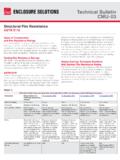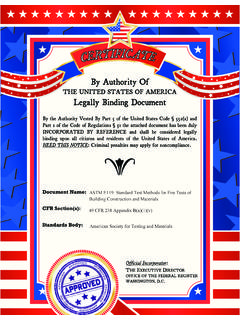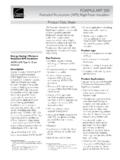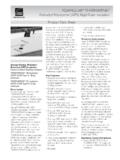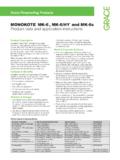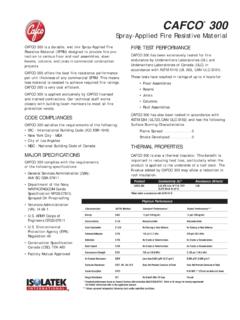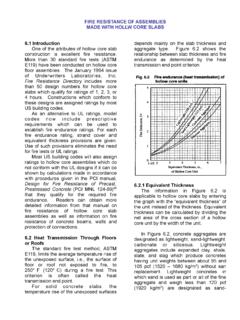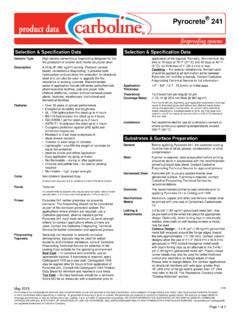Transcription of LIFE SAFETY DUCTS Fire Wrap Systems as …
1 Life SAFETY DUCTS such as those supplying fresh pressurization air to an exit stairwell or those designed to extract smoke from a fire area in a building are just a few amongst the many air distribution system (ADS) duct types required by code to be protected from fire in a commercial building. As building codes and fire test standards have evolved over the years, the presence and acceptance of flexible fire rated duct wrap Systems as alternative to gypsum shaft enclosures to provide the required hourly duration of protection has immensely wrap Systems as Alternative to fire Rated Shaft Constructionany situations present themselves in a commercial building that create an advantage for using flexible duct wrap Systems as an alternative to gypsum shaft assemblies to provide the necessary fire resistance rating. A few of these situations include: Lack of the necessary space required to build a properly constructed code compliant gypsum shaft Complex duct configurations Other construction items such as other DUCTS , pipes, equipment, and the support structures for such, creating additional space constraints Cross-over floor DUCTS that come out of one fire rated gypsum shaft, run horizontal to the other side of the building, and re-enter another gypsum shaft DUCTS that pass through fire rated stairwells and exit waysWhat is a flexible fire wrap system ?
2 They are referred to as Systems , since the flexible wrap products are fire tested in conjunction with the duct to be protected. Thus they are not fire rated wrap products , rather the product and duct tested together become the fire resistance-rated duct system . In contrast, a gypsum shaft assembly is not actually tested as four walls enclosing the duct , but rather as an individual shaftwall, which is clearly not a duct system . MMike KerrisonMike Kerrison is the fire Protection Product Manager at Unifrax I LLC with over 12 years experience in various engineering and marketing positions supporting the passive fire Protection Business. In addition to running full scale fire testing programs, during his time at Unifrax Mike has conducted numerous educational seminars for architectural firms, engineering firms, state and local code authorities, as well as insulation and mechanical contracting companies. duct with complex geometry, close to other service SAFETY DUCTS Subscribe at 2015 INTERNATIONAL fire PROTECTION 17 Image courtesy of UnifraxFlexible fire wrap products typically consist of high temperature (operating temperatures upwards of 2000 F), low bio persistence fiber blankets completely encapsulated in scrim reinforced foil.
3 These fiber blankets typically do not utilize organic binders, rather they are manufactured with a needling process intertwining the fibers creating a completely noncombustible product form. The scrim reinforced foil encapsulation adds handing strength for installation, helps the product resist moisture, as well as providing a location to print the product identification and certification information for use by Code Officials to properly identity the product typesAs previously mentioned, there are many duct types that are required by the building codes to be protected from fire . Among the list of those duct types include: Stairwell and vestibule pressurization Smoke control Supply/return Commercial dryer exhaust Hazardous and laboratory exhaust Bathroom and toilet exhaustAdvantages of using flexible wrap Systems Thin profile uses less space than shaft construction allowing more habitable square footage in a given building space and solves space constraint issues Easily contours to accommodate complex duct configurations Lightweight material (typically 6 lbs/ft3 density) allows for easy handling Installed cost lower than gypsum shaft construction Listed and Labeled Systems fire tested as one complete system with the ductApproval processSince the International Building Code (IBC )
4 Published by the International Code Council, enforced throughout the United States, does not define requirements for shaft alternatives for ADS DUCTS with the exception of commercial kitchen grease DUCTS (ASTM E2336 is used for grease DUCTS , listed in the International Mechanical Code IMC ), section of the IBC is utilized for alternate Systems approval. Section titled Alternative materials, design and methods of construction and equipment states: An alternative material, design or method of construction shall be approved where the building official finds that the proposed design is satisfactory and complies with the intent of the provisions of this code, and that the material, method or work offered is, for the purpose intended, at least the equivalent of that prescribed in this code in quality, strength, effectiveness, fire resistance, durability and SAFETY . Further to this, section of the IBC titled Alternative methods for determining fire resistance provides additional information for alternative methods for fire resistance rated assemblies as suggested by the general, approval for use is achieved by providing documentation for tested, Listed and Labeled Systems .
5 The term Listed and Labeled Systems refers to Systems that are tested at, and Listed and Labeled by an IAS (International Accreditation Service) accredited testing organization. With this, the manufacturer abides to a Follow up Service program in which the manufacturing facility is randomly visited by a laboratory representative to witness material production and verify the material is consistently being produced within the duct passing through exit stairwell. duct with insufficient space to construct proper code compliant SAFETY DUCTS INTERNATIONAL fire PROTECTION SEPTEMBER 2015 7 Images courtesy of Unifrax7 Image courtesy of UnifraxLIFE SAFETY DUCTS Subscribe at 2015 INTERNATIONAL fire PROTECTION 3specification of that fire tested. Intertek Testing Services and Underwriters Laboratories are both examples of IAS accredited years, fire resistance-rated duct Systems utilizing flexible fire wrap products were approved on a case by case basis for projects, upon special request.
6 As the industry, education, and awareness of said Systems has evolved over the years, it has moved in the direction of accepted practice as opposed to case by case. These Systems are being specified by Architects and Engineers alike as an alternative to gypsum shaft assemblies and widely accepted throughout North America by Code criteriaSection of the IBC as previously referenced states The application of any of the alternative methods listed in this section shall be based on the fire exposure and acceptance criteria specified in ASTM E119 or UL 263. Due to the lack of a fire test standard that addresses ADS duct performance in a fire scenario (other than grease duct Systems ) utilizing ASTM E119 time-temperature fire exposure, ISO 6944-1985 fire Resistance Tests Ventilation DUCTS (BS 476: Part 24) is the recognized standard used for testing flexible fire wrap ADS duct Systems . This fire test standard utilizes the ISO 834 time-temperature fire exposure curve.
7 In 1987, a study was conducted by The American Society for Testing and Materials (ASTM) and the National Research Council Canada (NRCC) comparing the ASTM E119 and ISO 834 time-temperature fire exposure conditions. The results were compiled in ASTM s Journal of Testing and Evaluation in a publication titled Comparison of Severity of Exposure in ASTM E119 and ISO 834 fire Resistance Tests . The results showed that for fire tests in duration upwards of hours, the exposure differences between the two are negligible, thus providing technical justification for acceptance of ISO 6944-1985 tested 6944-1985 uses three specific performance criteria for reporting the fire resistance rating of the duct system . The rating (tested in both vertical and horizontal orientations) is the duration in minutes when exposed to ISO 834 time-temperature fire exposure conditions until failure occurs per one or more of the following: Stability When the duct collapses in such a manner it no longer fulfills its intended function Insulation Temperature rise limit on the duct wrap surface outside the furnace exceeds pass/fail Integrity Passage of flames or hot gases enough to create flaming on the unexposed sideIn order to be considered as a shaft alternative per the above criteria, all three performance criteria must be achieved to equal or greater hourly duration than that of the required shaft enclosure.
8 The IBC section 707 requires shafts that penetrate four stories or higher to be two hour fire resistance rated, with three stories or less being one hour. In addition to that, Systems are tested, Listed and Labeled per ASTM E814 Standard Test Method for fire Tests of Penetration Firestop Systems . Testing to this standard demonstrates that for locations where the fire resistive duct system passes through fire resistance rated walls and floors, it maintains the fire resistance rating of the wall or floor penetrated by selecting the system with equal hourly ratings of that being penetrated. Two hourly ratings are established and reported: F Rating No flaming on the unexposed surface T Rating Temperature rise criteria on the surface of the penetrating item remains below pass/fail temperatures (325 F over ambient)New fire test standard ASTM E2816 Due to the code structure and requirements for ASTM E119 time-temperature fire exposure conditions within code Section of the IBC, demand for development of a new standard to evaluate ADS duct Systems (except grease DUCTS ) per ASTM E119 criteria continued to increase.
9 ASTM E2816 Standard Test Methods for fire Resistive Metallic HVAC duct Systems was first published in 2009, the result of extensive industry input and a consensus based process. Over the following few years, the standard content was revised for clarity and usability .This fire test standard utilizes ASTM E119 time-temperature fire exposure conditions to evaluate four separate full size duct configurations: horizontal-open, vertical-open, horizontal-closed, and vertical-closed, thus evaluating for fire inside and outside the duct scenarios. This standard also includes evaluation and reporting of the mechanical support Systems for the duct as well as well as transition connections from vertical to horizontal duct configurations. In addition, this standard evaluates a number of attributes of the flexible fire wrap materials protecting the duct including the combustibility, flame spread and smoke generation, and durability properties.
10 ASTM E814 testing of the through penetration firestop system as described above is also included within this standard. duct above drop ceiling lacking space for proper shaft SAFETY DUCTS INTERNATIONAL fire PROTECTION SEPTEMBER 2015 Grease duct Systems paved the waySection of the International Mechanical Code (IMC) titled Field-applied grease duct enclosure states Commercial kitchen grease DUCTS constructed in accordance with Section shall be enclosed by field applied grease duct enclosure that is a listed and labeled material, system , product, or method of construction specifically evaluated for such purpose in accordance with ASTM E2336. While flexible fire wrap Systems have been used for grease DUCTS dating back to before the year 2000 and accepted as alternate Systems , it wasn t until the 2006 edition of the IMC when ASTM E2336 was written into the code. While initially listed as an exception to the shaft requirement it was later moved to its own section in 2009.
